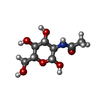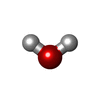[English] 日本語
 Yorodumi
Yorodumi- EMDB-46781: Cryo-EM structure of the human P2X2 receptor in the apo closed state -
+ Open data
Open data
- Basic information
Basic information
| Entry |  | |||||||||
|---|---|---|---|---|---|---|---|---|---|---|
| Title | Cryo-EM structure of the human P2X2 receptor in the apo closed state | |||||||||
 Map data Map data | Locally sharpened map for hP2X2 in the apo closed state | |||||||||
 Sample Sample |
| |||||||||
 Keywords Keywords | Membrane Protein / Ion Channel / Ligand-gated Ion Channel / P2X Receptor / P2XR | |||||||||
| Function / homology |  Function and homology information Function and homology informationdetection of hypoxic conditions in blood by carotid body chemoreceptor signaling / Platelet homeostasis / extracellularly ATP-gated monoatomic cation channel activity / purinergic nucleotide receptor activity / peristalsis / Elevation of cytosolic Ca2+ levels / neuromuscular synaptic transmission / urinary bladder smooth muscle contraction / response to carbohydrate / ligand-gated monoatomic ion channel activity ...detection of hypoxic conditions in blood by carotid body chemoreceptor signaling / Platelet homeostasis / extracellularly ATP-gated monoatomic cation channel activity / purinergic nucleotide receptor activity / peristalsis / Elevation of cytosolic Ca2+ levels / neuromuscular synaptic transmission / urinary bladder smooth muscle contraction / response to carbohydrate / ligand-gated monoatomic ion channel activity / response to ATP / neuromuscular junction development / behavioral response to pain / positive regulation of calcium ion transport into cytosol / neuronal dense core vesicle / skeletal muscle fiber development / positive regulation of calcium-mediated signaling / response to ischemia / sensory perception of sound / calcium ion transmembrane transport / sensory perception of taste / response to hypoxia / receptor complex / postsynapse / apical plasma membrane / neuronal cell body / ATP binding / identical protein binding / plasma membrane Similarity search - Function | |||||||||
| Biological species |  Homo sapiens (human) Homo sapiens (human) | |||||||||
| Method | single particle reconstruction / cryo EM / Resolution: 2.71 Å | |||||||||
 Authors Authors | Westermann FG / Oken AC / Muller CE / Mansoor SE | |||||||||
| Funding support |  United States, 2 items United States, 2 items
| |||||||||
 Citation Citation |  Journal: Proc Natl Acad Sci U S A / Year: 2025 Journal: Proc Natl Acad Sci U S A / Year: 2025Title: Subtype-specific structural features of the hearing loss-associated human P2X2 receptor. Authors: Franka G Westermann / Adam C Oken / Philip K E Granith / Parthiban Marimuthu / Christa E Müller / Steven E Mansoor /    Abstract: The P2X2 receptor (P2X2R) is a slowly desensitizing adenosine triphosphate (ATP)-gated ion channel that is highly expressed in the cochlea. When mutated, the P2X2R exacerbates age- and noise-related ...The P2X2 receptor (P2X2R) is a slowly desensitizing adenosine triphosphate (ATP)-gated ion channel that is highly expressed in the cochlea. When mutated, the P2X2R exacerbates age- and noise-related hearing loss, but selective modulators of the receptor are lacking, and the molecular basis of activation and desensitization remains poorly understood. Here, we determine high-resolution cryoelectron microscopy structures of the full-length wild-type human P2X2R in an apo closed state and two distinct ATP-bound desensitized states. In the apo closed state structure, we observe features unique to the P2X2R and locate disease mutations within or near the transmembrane domain. In addition, our ATP-bound structures show how free anionic ATP forms subtype-specific interactions with the orthosteric binding site. We identify and characterize two different ATP-bound desensitized state structures, one similar to published models for other P2XR subtypes, and a second alternate conformation not previously observed. A loop adjacent to the orthosteric binding site between these two ATP-bound desensitized state structures undergoes significant conformational changes. These movements are supported by multireplicate, microsecond-scale molecular dynamics simulation studies and suggest a path by which ATP could enter or leave the orthosteric pocket. Together, our results provide structural insights into the P2X2R, facilitating structure-based drug development for this therapeutically important target. | |||||||||
| History |
|
- Structure visualization
Structure visualization
| Supplemental images |
|---|
- Downloads & links
Downloads & links
-EMDB archive
| Map data |  emd_46781.map.gz emd_46781.map.gz | 392.8 MB |  EMDB map data format EMDB map data format | |
|---|---|---|---|---|
| Header (meta data) |  emd-46781-v30.xml emd-46781-v30.xml emd-46781.xml emd-46781.xml | 21 KB 21 KB | Display Display |  EMDB header EMDB header |
| FSC (resolution estimation) |  emd_46781_fsc.xml emd_46781_fsc.xml | 16.5 KB | Display |  FSC data file FSC data file |
| Images |  emd_46781.png emd_46781.png | 105.4 KB | ||
| Masks |  emd_46781_msk_1.map emd_46781_msk_1.map | 476.8 MB |  Mask map Mask map | |
| Filedesc metadata |  emd-46781.cif.gz emd-46781.cif.gz | 6.1 KB | ||
| Others |  emd_46781_additional_1.map.gz emd_46781_additional_1.map.gz emd_46781_additional_2.map.gz emd_46781_additional_2.map.gz emd_46781_half_map_1.map.gz emd_46781_half_map_1.map.gz emd_46781_half_map_2.map.gz emd_46781_half_map_2.map.gz | 237.2 MB 450.2 MB 442 MB 442 MB | ||
| Archive directory |  http://ftp.pdbj.org/pub/emdb/structures/EMD-46781 http://ftp.pdbj.org/pub/emdb/structures/EMD-46781 ftp://ftp.pdbj.org/pub/emdb/structures/EMD-46781 ftp://ftp.pdbj.org/pub/emdb/structures/EMD-46781 | HTTPS FTP |
-Validation report
| Summary document |  emd_46781_validation.pdf.gz emd_46781_validation.pdf.gz | 779.5 KB | Display |  EMDB validaton report EMDB validaton report |
|---|---|---|---|---|
| Full document |  emd_46781_full_validation.pdf.gz emd_46781_full_validation.pdf.gz | 779 KB | Display | |
| Data in XML |  emd_46781_validation.xml.gz emd_46781_validation.xml.gz | 25.7 KB | Display | |
| Data in CIF |  emd_46781_validation.cif.gz emd_46781_validation.cif.gz | 33.9 KB | Display | |
| Arichive directory |  https://ftp.pdbj.org/pub/emdb/validation_reports/EMD-46781 https://ftp.pdbj.org/pub/emdb/validation_reports/EMD-46781 ftp://ftp.pdbj.org/pub/emdb/validation_reports/EMD-46781 ftp://ftp.pdbj.org/pub/emdb/validation_reports/EMD-46781 | HTTPS FTP |
-Related structure data
| Related structure data |  9ddvMC  9ddwC  9ddxC M: atomic model generated by this map C: citing same article ( |
|---|---|
| Similar structure data | Similarity search - Function & homology  F&H Search F&H Search |
- Links
Links
| EMDB pages |  EMDB (EBI/PDBe) / EMDB (EBI/PDBe) /  EMDataResource EMDataResource |
|---|
- Map
Map
| File |  Download / File: emd_46781.map.gz / Format: CCP4 / Size: 476.8 MB / Type: IMAGE STORED AS FLOATING POINT NUMBER (4 BYTES) Download / File: emd_46781.map.gz / Format: CCP4 / Size: 476.8 MB / Type: IMAGE STORED AS FLOATING POINT NUMBER (4 BYTES) | ||||||||||||||||||||||||||||||||||||
|---|---|---|---|---|---|---|---|---|---|---|---|---|---|---|---|---|---|---|---|---|---|---|---|---|---|---|---|---|---|---|---|---|---|---|---|---|---|
| Annotation | Locally sharpened map for hP2X2 in the apo closed state | ||||||||||||||||||||||||||||||||||||
| Projections & slices | Image control
Images are generated by Spider. | ||||||||||||||||||||||||||||||||||||
| Voxel size | X=Y=Z: 0.648 Å | ||||||||||||||||||||||||||||||||||||
| Density |
| ||||||||||||||||||||||||||||||||||||
| Symmetry | Space group: 1 | ||||||||||||||||||||||||||||||||||||
| Details | EMDB XML:
|
-Supplemental data
-Mask #1
| File |  emd_46781_msk_1.map emd_46781_msk_1.map | ||||||||||||
|---|---|---|---|---|---|---|---|---|---|---|---|---|---|
| Projections & Slices |
| ||||||||||||
| Density Histograms |
-Additional map: Unsharpened map for hP2X2 in the apo closed state
| File | emd_46781_additional_1.map | ||||||||||||
|---|---|---|---|---|---|---|---|---|---|---|---|---|---|
| Annotation | Unsharpened map for hP2X2 in the apo closed state | ||||||||||||
| Projections & Slices |
| ||||||||||||
| Density Histograms |
-Additional map: Globally sharpened map for hP2X2 in the apo closed state
| File | emd_46781_additional_2.map | ||||||||||||
|---|---|---|---|---|---|---|---|---|---|---|---|---|---|
| Annotation | Globally sharpened map for hP2X2 in the apo closed state | ||||||||||||
| Projections & Slices |
| ||||||||||||
| Density Histograms |
-Half map: Half map A for hP2X2 in the apo closed state
| File | emd_46781_half_map_1.map | ||||||||||||
|---|---|---|---|---|---|---|---|---|---|---|---|---|---|
| Annotation | Half map A for hP2X2 in the apo closed state | ||||||||||||
| Projections & Slices |
| ||||||||||||
| Density Histograms |
-Half map: Half map B for hP2X2 in the apo closed state
| File | emd_46781_half_map_2.map | ||||||||||||
|---|---|---|---|---|---|---|---|---|---|---|---|---|---|
| Annotation | Half map B for hP2X2 in the apo closed state | ||||||||||||
| Projections & Slices |
| ||||||||||||
| Density Histograms |
- Sample components
Sample components
-Entire : Homotrimeric hP2X2
| Entire | Name: Homotrimeric hP2X2 |
|---|---|
| Components |
|
-Supramolecule #1: Homotrimeric hP2X2
| Supramolecule | Name: Homotrimeric hP2X2 / type: complex / ID: 1 / Parent: 0 / Macromolecule list: #1 |
|---|---|
| Source (natural) | Organism:  Homo sapiens (human) Homo sapiens (human) |
-Macromolecule #1: P2X purinoceptor 2
| Macromolecule | Name: P2X purinoceptor 2 / type: protein_or_peptide / ID: 1 / Number of copies: 3 / Enantiomer: LEVO |
|---|---|
| Source (natural) | Organism:  Homo sapiens (human) Homo sapiens (human) |
| Molecular weight | Theoretical: 51.814996 KDa |
| Recombinant expression | Organism:  Homo sapiens (human) Homo sapiens (human) |
| Sequence | String: MAAAQPKYPA GATARRLARG CWSALWDYET PKVIVVRNRR LGVLYRAVQL LILLYFVWYV FIVQKSYQES ETGPESSIIT KVKGITTSE HKVWDVEEYV KPPEGGSVFS IITRVEATHS QTQGTCPESI RVHNATCLSD ADCVAGELDM LGNGLRTGRC V PYYQGPSK ...String: MAAAQPKYPA GATARRLARG CWSALWDYET PKVIVVRNRR LGVLYRAVQL LILLYFVWYV FIVQKSYQES ETGPESSIIT KVKGITTSE HKVWDVEEYV KPPEGGSVFS IITRVEATHS QTQGTCPESI RVHNATCLSD ADCVAGELDM LGNGLRTGRC V PYYQGPSK TCEVFGWCPV EDGASVSQFL GTMAPNFTIL IKNSIHYPKF HFSKGNIADR TDGYLKRCTF HEASDLYCPI FK LGFIVEK AGESFTELAH KGGVIGVIIN WDCDLDLPAS ECNPKYSFRR LDPKHVPASS GYNFRFAKYY KINGTTTRTL IKA YGIRID VIVHGQAGKF SLIPTIINLA TALTSVGVGS FLCDWILLTF MNKNKVYSHK KFDKVCTPSH PSGSWPVTLA RVLG QAPPE PGHRSEDQHP SPPSGQEGQQ GAECGPAFPP LRPCPISAPS EQMVDTPASE PAQASTPTDP KGLAQL UniProtKB: P2X purinoceptor 2 |
-Macromolecule #2: 2-acetamido-2-deoxy-beta-D-glucopyranose
| Macromolecule | Name: 2-acetamido-2-deoxy-beta-D-glucopyranose / type: ligand / ID: 2 / Number of copies: 6 / Formula: NAG |
|---|---|
| Molecular weight | Theoretical: 221.208 Da |
| Chemical component information |  ChemComp-NAG: |
-Macromolecule #3: water
| Macromolecule | Name: water / type: ligand / ID: 3 / Number of copies: 180 / Formula: HOH |
|---|---|
| Molecular weight | Theoretical: 18.015 Da |
| Chemical component information |  ChemComp-HOH: |
-Experimental details
-Structure determination
| Method | cryo EM |
|---|---|
 Processing Processing | single particle reconstruction |
| Aggregation state | particle |
- Sample preparation
Sample preparation
| Buffer | pH: 7 |
|---|---|
| Vitrification | Cryogen name: ETHANE / Instrument: FEI VITROBOT MARK IV |
- Electron microscopy
Electron microscopy
| Microscope | FEI TITAN KRIOS |
|---|---|
| Specialist optics | Energy filter - Slit width: 20 eV |
| Image recording | Film or detector model: GATAN K3 BIOCONTINUUM (6k x 4k) / Number real images: 33324 / Average electron dose: 45.0 e/Å2 |
| Electron beam | Acceleration voltage: 300 kV / Electron source:  FIELD EMISSION GUN FIELD EMISSION GUN |
| Electron optics | C2 aperture diameter: 70.0 µm / Calibrated magnification: 130000 / Illumination mode: FLOOD BEAM / Imaging mode: BRIGHT FIELD / Cs: 2.7 mm / Nominal defocus max: 1.5 µm / Nominal defocus min: 0.9 µm |
| Sample stage | Specimen holder model: FEI TITAN KRIOS AUTOGRID HOLDER |
| Experimental equipment |  Model: Titan Krios / Image courtesy: FEI Company |
 Movie
Movie Controller
Controller





 Z (Sec.)
Z (Sec.) Y (Row.)
Y (Row.) X (Col.)
X (Col.)






























































